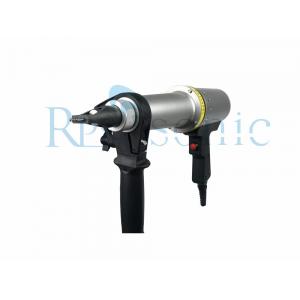

Add to Cart
Parameter:
What's is ultrasonic impact treatment
Ultrasonic impact treatment is a method to efficiently remove the
residual tensile stress on the surface of the workpiece or the weld
zone, and form a compressive stress on the surface of the
workpiece. Can significantly improve the fatigue life and fatigue
strength of welded joints. After welding, the toe area is processed
to make the transition smooth, thereby reducing the stress
concentration caused by the remaining height and eliminating
defects on the surface of the toe; at the same time, a large
compressive plastic deformation is generated at the toe, which
results in residual compressive stress and adjusts the welding
Residual stress field, and strengthen and harden the toe area. The
above factors effectively improve the fatigue performance of welded
joints.
Our company's ultrasonic impact equipment control power box adopts modular design and is manufactured by
applying advanced production technology based on the use of
high-quality materials and components. The control power supply has
a frequency phase-locked tracking system, and it is the first to
introduce a fully digital-based control power supply. It realizes
automatic frequency scanning, detection, tracking, automatic fault
detection and protection, preset control of power adjustment and
impedance adjustment, man-machine dialogue, software upgrade, etc.
The operation is very convenient and reliable.
A large amount of experimental data shows that ultrasonic impact
can increase the fatigue strength of steel welded joints by 60 ~
180% and extend the fatigue life by 10 ~ 135 times; increase the
fatigue strength of aluminum and titanium non-ferrous metal welded
joints by 26 ~ 48% and extend the fatigue life 5 ~ 45 times.
Ultrasonic impact gun products have also formed a series of
products, which can be widely used in ships, petrochemicals,
aviation, railways, wind turbines, steel or composite bridges,
heavy lifting machinery and other fields, suitable for post-weld
processing of welding structures of various materials To achieve
the purpose of extending the fatigue life of the welded structure
and improving its fatigue strength, and can eliminate the welding
process stress and residual stress to a certain extent, it is
especially suitable for post-weld processing of ordinary joints,
load-bearing joints and welded joints of dissimilar materials.
Application:
Inscreasing productivity and quality
Cost reductions
Improving fatigue life
Treatment of complex geometry parts
Process control and repeatability
Low roughness (see image above)
Shorter treatment cycle time
Reducing consumption of beads, energy and compressed air
Integration in the production line (lean manufacturing)
Impact gun application areas: industries that have strict requirements on the stability and strength of the weld. Such as: bridges, electric power; shipbuilding; pressure vessel, steel structure and other metal welding industries.
